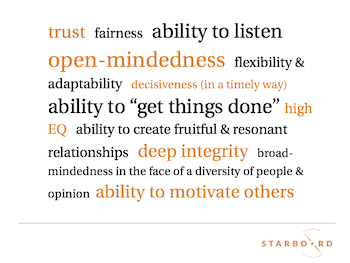Leadership, Diversity & High-Performing Teams
Most of us have managed teams. Probably in equal measure, we’ve rejoiced in their collective achievements or wrangled over misalignment, clashing agendas and shared underperformance. Teams have a life of their own; their own distinct sub-culture, driven by the personalities, the expertise, and the backgrounds of those within them, and the subtle interplay of all these factors. A change within a high-performing team can take us back to square one.
But we can’t get things done alone. However we configure the structure of our business, teams are a necessity. We are dependent upon one other not only to achieve individual goals but to contribute to the broader purpose. So we need to find ways of getting the right balance of collaboration and support, debate and friction, in order to achieve the highest levels of team performance. This month we focus on the key elements of team high performance:
- The characteristics of high-performing teams and the strategies that create them. Read more
- The effects of leadership and diversity on teams.
According to the University of Virginia research on teams, the quality of leadership and level of diversity in teams are massive indicators of performance [1].
Diverse teams with great leaders are relatively few, but as they outperform all other types of teams, striving to create them should be the holy grail of our talent management strategies. The common perception is that diverse teams are more innovative and creative. However, diverse teams which are managed poorly, in fact perform the worst of all, lagging behind homogenous teams.
Speaking in the light of ever-increasing support for LGBT inclusion in the Armed Services, the Army’s Operations Chief, Lt General James Everard, said “Diverse teams, well led, give you a breadth of understanding and capability you don’t get in any other way.” In 2013, the army ranked 128th in Stonewall’s list of leading LGBT employers. In 2014 it came 79th. And in 2015, it came 46th, showing its ongoing commitment to increasing diversity, while maintaining strength and depth in leadership.
Encouraging Diversity
Differences in age, race, gender, and sexuality are key for a team’s diversity; however, differences in skills, working styles and opinions are also significant. The best performing team is generally not the one with the greatest collective IQ, but the one with the most complementary skills and knowledge amongst its members. Diversity of opinion spurs debate between team members, improving both innovation and problem solving [2].
Organisations can enhance diversity by encouraging employees to be themselves. If an organisational culture promotes authenticity, then more diversity within teams is an outcome. Conversely, if a culture is stifling, teams are much more likely to be homogenous, and therefore lacking the capacity for the highest levels of performance.
The benefit of programmes which define organisational values, competencies, behaviours, and leadership frameworks aren’t in question, as long they are not, as the HR Director at the NSPCC, Siobhan Sheridan puts it, “responsible for asking people to ‘become’ something that they are not.”
Are your teams “well-led”?
It’s quite some list, but the best leaders, who enable the highest performing teams, have learnt to consistently demonstrate these traits:

In addition to this, existing or emerging leaders and managers need to be able to communicate strategy and purpose clearly and with impact to their teams. When they have communicated the purpose, they then need to take a step back and empower their people to deliver – difficult as this may be in practice.
Good leaders have integrity above all else. Increasingly savvy customers will only stay loyal to organisations who demonstrate integrity, and the same is true for employees. Word gets around, and millennials in particular, set a high price on transparency and integrity.
In summary, great leadership; engaged, collaborative teams; and team members who feel safe to express their individual preferences and opinions are key ingredients for creating teams who will consistently deliver high performance.
Talk to us now to learn more about our work with clients, which has enabled both individual and team high performance.
To read more about the characteristics of high-performing teams, see our article here.
[1] Creating Value with Diverse Teams in Global Management, Martha Maznevski, Jospeh J. DiStefano.
[2] Gallup What Strong Teams Have in Common.
© Cath Longfield, Starboard

